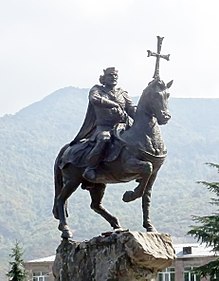Ashot II of Armenia
| Ashot II | |
|---|---|
| King of Armenia | |
| Reign | 914-929 |
| Predecessor | Smbat I |
| Successor | Abas I |
| Born | 882 |
| Died | 929 |
| Spouse | Marie of Artsakh |
| Dynasty | Bagratuni |
| Father | Smbat I |
| Religion | Armenian Apostolic |
Ashot II the Iron (Armenian: Աշոտ Բ; r. 914–929) was an Armenian king of the royal Bagratuni line. He was the son and successor of King Smbat I. His reign was filled with rebellions by pretenders to the throne, and foreign invasions, which Ashot fought off successfully, for which he is remembered by the epithet Yerkat (Երկաթ), or the Iron.[1]
Reign[]

Ashot II had succeeded his father Smbat I upon the latter's death in 914. Smbat had fought off an invasion launched by the emir of Atropatene, Yusuf Ibn Abi'l-Saj, but when Smbat surrendered he was tortured and beheaded by Yusuf in Yernjak. With his control of the central lands of Armenia, Yusuf installed Ashot, son of Shapuh and first cousin of Ashot II, in Dvin as the "anti-king" of Bagratid Armenia.[2] Harried by Yusuf's forces, Ashot visited Constantinople to receive aid from Empress Zoe Karbonopsina.[3] Ashot was well received, and a Byzantine force was created to assist Armenia in defeating the Arabs. The force, accompanying Ashot and led by the Domestic of the Schools Leo Phokas the Elder, moved out the next year and marched along Upper Euphrates, entering Taron, meeting scant opposition from the Arabs.[4]
Ashot the king and Yusuf's armies were unable to stop the Byzantine advance, which stopped short of capturing Dvin due to the onset of winter. Nevertheless, the force had returned Ashot to a powerful position in Armenia and managed to inflict heavy casualties against the Arabs.[5] This still left Ashot the king in control of Dvin and civil war raged on from 918 to 920, when the pretender finally conceded defeat. Numerous other rebellions in Armenia also took place but Ashot was able to defeat each one of them. In 919, Yusuf had instigated a failed rebellion against the caliph and was replaced by a far more well-disposed Arab governor, Subuk. In 922 he was recognized as the ruler of Armenia by the Abbasid caliph in Baghdad and Subuk recognized him as shahanshah, or "king of kings".[6]
The Byzantines were distressed with Ashot's close relations with the Arabs and dispatched a new force under the Domestic of the Schools John Kourkouas, also of Armenian descent, to disrupt Ashot's position as king and to support the rebels fighting him. In 928, Kourkouas reached Dvin in an unsuccessful attempt to capture a city that was defended by both the Arabs and Ashot. In 923, the caliph, facing troubles at home, released Yusuf, who traveled back to Armenia to unleash his fury against Ashot.[7] He began demanding tribute from the Armenians rulers but faced considerable resistance by Ashot II. Time and again, Ashot was able to defeat and rout the Arab armies sent against him for several years. Byzantine emperor Romanos I Lekapenos also turned his attention from the east to fight the Arabs in Syria. Ashot died without any sons or heirs. He was succeeded in 929 by his brother Abas I.
Family[]
Ashot was married to Marie, daughter of Prince Sahak, founder of the Kingdom of Artsakh.[8] The Armenian chronicler Stephen of Taron mentioned no children. A disputed claim (citation needed) gives him a daughter named Ripsimia, who married a man that moved to Bulgaria and ruled as Count Nicholas in the lands of the First Bulgarian Empire. They were the co-founders of the Cometopuli dynasty of Bulgaria and their youngest son was Tsar Samuel of Bulgaria.[9][10][11]
In modern day Armenia[]
During the 2016 the Independence Day parade, honor guards posted the flag of King Ashot II the Iron before the parade proceedings.[12] Ashot II has often been referred to as the "Guardian of the Armenian Army", a title that was given in 2012.[12][13]
Popular culture[]
Ashot II features prominently as a character in Muratsan's nineteenth-century historical novel Gevorg Marzpetuni.
References[]
- ^ (in French) Adontz, Nicholas, "Ašot Erkat' ou de fer roi d'Arménie de 913 à 929," Annuaire de l'Institute de philologie et d'histoire orientales et slaves 3 (1935), pp. 13-35.
- ^ Garsoïan, Nina G. (1997), "The Independent Kingdoms of Medieval Armenia" in The Armenian People from Ancient to Modern Times, Volume I, The Dynastic Periods: From Antiquity to the Fourteenth Century, ed. Richard G. Hovannisian. New York: St. Martin's Press, pp. 158-59.
- ^ Runciman, Steven (1929), The Emperor Romanus Lecapenus and His Reign: A Study of Tenth-Century Byzantium. Cambridge: Cambridge University Press, pp. 129-33, 154-56.
- ^ Runciman. Romanus Lecapenus, p. 131.
- ^ Treadgold, Warren (1997). A History of Byzantine State and Society. Stanford: Stanford University Press. p. 474.
- ^ Garsoïan. "The Independent Kingdoms of Medieval Armenia," p. 160.
- ^ Runciman. Romanus Lecapenus, p. 134.
- ^ Yovhannes Drasxanakertc'i (1987), History of Armenia, trans. Krikor Maksoudian. Atlanta, GA: Scholar's Press, p. 290, note 8.
- ^ Adontz, Nicholas (1938). "Samuel l'Armenien, roi des Bulgares". Mar BCLSMP (in French) (39): 37.
- ^ David Marshall Lang, The Bulgarians: from pagan times to the Ottoman conquest, Westview Press, 1976, p. 67.
- ^ Tom Winnifrith, Badlands, Borderlands: A History of Northern Epirus/Southern Albania, Duckworth, 2002, p. 83.
- ^ Jump up to: a b LLC, Ayb Solutions. "ՄԵՐ ԻՐԱՎՈՒՆՔԸ ԵՎ ԱԶԱՏՈՒԹՅՈՒՆԸ ՊԱՇՏՊԱՆՈՂ ՈՒԺԸ". Hay Zinvor. Retrieved 2021-03-06.
- ^ "Հայոց բանակին պահապան հռչակվեց Աշոտ Երկաթ թագավորի Սուրբ Խաչը" (in Armenian). Retrieved 2021-03-06.
- Bagratuni dynasty
- Kings of Bagratid Armenia
- 928 deaths
- 10th-century monarchs in Asia
- 10th-century Armenian people
